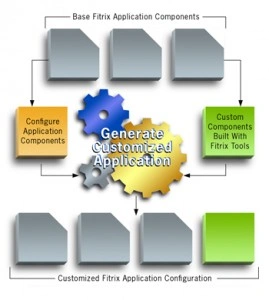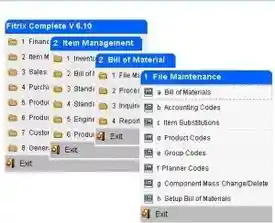Have you tried to buy a pair of running shoes lately? The first thing you may discover is that you are not even at the right store. That’s how specialized our economy has become. Go to a store that caters to a different type of customer and you’ll wind up with a poor fit and limited choices. ERP software works the same way - your company size, feature fit and corporate culture all matter, so you need to find an ERP Software package and vendor that share the same long term goals.
We only work with small and medium sized companies that make something with a significant electronics component, even though our software extends to companies outside our target market.
We give the most attention to customer requests that have value for our market. For example, when a customer requests a new feature, we ask ourselves “Would an electronics manufacturer need this feature?” If the answer is yes, we add the feature to our product and all of the customers in our target market benefit.
If the answer is no, then the feature is built as a custom feature for that customer only. As much as we’d like to build every feature on every customer’s wish list, we wouldn’t be able to justify the business case. The exact opposite happens with our target market customers. We are excited to hear about a new electronics manufacturing feature that will benefit all of our customers.
Electronics manufactures have unique challenges:
- Electronics manufacturers have more intensive inventory requirements than most industries.
- Supplier lead times may be long so the ability to track vendor performance is important.
- Serial numbers and lot numbers may be important – and not just for the finished part or top level components, but all the way through the BOM levels.
- Components may constantly have new revision levels that need to be tracked.
- Traceability and recall is critical – from supplier through manufacturing through sales and for a long time after the sale.
- RMA tracking is critical.
- Warranty tracking is critical.
- Inventory visibility at every level is essential!
- If component lead times are long you have to be able to forecast accurately and plan ahead!
- With electronics you often need to be able to get new products to market quickly and deal with rapid change. This requires a strong ERP system with good visibility and flexibility.
- Your supplier relationships are vital. Keeping a close eye on your suppliers and knowing how they are performing is imperative in keeping your lead times down and your quality up. Spotting small problems before they turn into big ones is key.
Your Company size matters:
If you are a small or medium sized electronics manufacturer, you need an ERP software package and vendor that are both oriented to your size business. If you aim too low, you might save money on the purchase but wind up with a system that won’t do the job and a vendor that assumes you want self-service and isn’t available to help you. If you aim too high, you will spend too much and get an overkill system that is too complex and cumbersome to use with a much higher cost of ownership.
Big ERP systems are designed for big businesses with more layers of management and more people doing more specific jobs. The duties of one person in your business may be done by ten people in a larger business. The big ERP software will divide these duties into more steps with more controls around them making it more work for the small to mid-size business user. The high end ERP software may also have a lot more features, but you probably won’t need most of them. You will find that they add complexity and ultimately slow you down and cost you money, from implementation, to training, to using the software on a day to day basis.
Low end software is designed for very small businesses and here the opposite happens. Instead of being designed for more layers of management and more discrete job descriptions, these packages are designed for mom and pop companies with no management layers and users that don’t want too many controls in place. These systems often let you make changes to completed transactions with no audit trail. That’s great if you are the only user and know what you want, not so great for your small or medium size business where controls are important. Low end systems may be easy to use but won’t handle your more complex processes, leaving it to you to supplement the software with spreadsheets and outside packages. Even if you can get by with this type of system, you won’t be able to scale for peak loads or grow your business.
The Feature Dilemma:
The potential feature list for ERP software is staggering. No ERP product has every feature, not even the biggest and most expensive system, and you wouldn’t want it if it did!
If you are a small or medium sized discrete manufacturer of electronics, you need an ERP software system that has a solid set of midrange accounting, supply chain and manufacturing features plus the unique or higher end features needed for electronics.
There are three classes of key features for electronics manufacturing:
1. Standard midrange ERP features: These are features that every midrange ERP software package should have but are often not found in low end software. This would include features like audit trails and more complex manufacturing tracking.
2. Selected high end ERP features: High end ERP systems will have thousands of features not found in midrange systems, but you only need a few of these.
For Example: “blanket sales orders” and “blanket purchase orders”. A lot of electronics manufacturers buy and sell this way. The challenge is to find a midrange ERP that is affordable, but also has all of the specific high end ERP features that you need.
3. Features only needed for electronics manufacturing: An example would be an automatic tie in to an electronic part life cycle database so that up to date life cycle data is available in your ERP system to aid in decision making. Not even the best high end ERP software will have features in this class unless it is specifically focused on electronics.
Your Choices:
Choose a high end ERP system
This system will be expensive to purchase, expensive to own, cumbersome to operate due to complexities and features you won’t need and you will still need to add the electronics only features through customizations.
Choose a general purpose midrange ERP system and customize it
Many companies have resorted to this but the customization will probably cost more than the ERP software. A customized system will be expensive to maintain and you miss out on the long term benefit of new features requested by other customers in your industry. If you have a truly unique requirement, by all means address it with a software customization. However you don’t want to resort to software customizations when the right package has the features as standard.
Find an ERP package that is focused on both your company size and on electronics manufacturing that will address your industry’s very specific list of feature goals
It never works out well in the long run when you choose an ERP solution that is intended for a different type of business than yours. The vendor might be flexible at first, but ultimately won’t be able to meet your long-term expectations. Choosing the right ERP software is not just a matter of features, it’s also about the support style and capabilities, pricing structure and 3rd party connectors available. When we hear about another great electronics manufacturing feature, we get excited and start figuring out how to add it to Fitrix. That’s the value of an industry specific product.
We operate in a highly specialized economy that gives us all a lot of choices. Fitrix ERP is built on technology that makes it easy to access those choices. Be diligent and do the work up front to find the right ERP software for your business. Success will surely follow.


